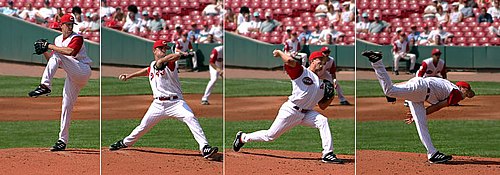Work (physics)
In physics, work is what force does.

When a force is applied on an object for a certain amount of time, the work done by the force is defined as the magnitude of the force (its strength) times the displacement of the object from its initial position to its current position (shortest distance between point A and B), times the cosine of the angle between the direction of the force and the actual direction of the displacement of the object. This can be represented by:
In this formula, work is W, the force's magnitude is F, the displacement is s, and the angle's cosine is cos θ.
In most circumstances, the last factor (the cosine of the angle) is equal to one because the direction of the force is usually the same direction of the displacement. But in circumstances like pushing a heavy box at an angle not parallel to the ground (let's say pushing it at 20° towards the ground), the direction of the force is not the same as the direction of the displacement. In this example, because of the angle of the applied force, the force is doing less work because it is not as efficient as pushing the box at an angle parallel to the ground.
The more the direction of the displacement gets perpendicular (90°) to the direction of the force, the more the work approaches zero. If the angle is greater than 90°, that indicates the object is overall moving in a backwards direction from what the force intends to do; the force has negative work.
One useful example is a scenario of a group of people playing tug of war. The team that is slowly getting pulled into the middle is exerting a force away from the middle, but despite the best efforts of their forces, there is negative work because the direction of their displacement is in the opposite direction.
Holding a heavy book against its weight produces a force, but if the object is stationary in the air, no work is done. If the object slowly moves upwards, work is positive, but if instead it's slowly descending despite the force's exertion on it, the force has negative work.
We can also look at this from the perspective of the force that is trying to move the book downwards, its weight. The work of the weight on a book being lifted is negative. This is because the downward weight is in the opposite direction to the upward displacement.
Work is considered done when it is positive.
It is the force that does the work, not the agent that created the force.[1] Motion is a requirement of work.
Like energy, it is a scalar quantity, and its SI unit is the joule.[2] Heat conduction is not considered to be a form of work, since there is no macroscopically measurable force, only microscopic forces occurring in atomic collisions. The term work was created in the 1830s by the French mathematician Gaspard-Gustave Coriolis.[3]
According to the work-energy theorem, if an external force acts upon a rigid object, causing its kinetic energy to change from Ek1 to Ek2, then the mechanical work (W) is given by:[4]
where m is the mass of the object and v is the object's velocity.
References
change- ↑ "Definition of Work in Physics". Western Washington University. Archived from the original on 2014-11-04. Retrieved 2016-06-13.
{{cite web}}: CS1 maint: bot: original URL status unknown (link) - ↑ Holzner, Steven (2010). Physics Essentials For Dummies. Wiley Publishing. p. 78. ISBN 978-0-470-61841-7.
- ↑ Jammer, Max (1957). Concepts of Force. Dover Publications, Inc. ISBN 0-486-40689-X.
- ↑ Tipler (1991), page 138.
Other websites
change- Work Archived 2010-12-14 at the Wayback Machine - a chapter from an online textbook
- Work, Power, Kinetic Energy on Project PHYSNET

